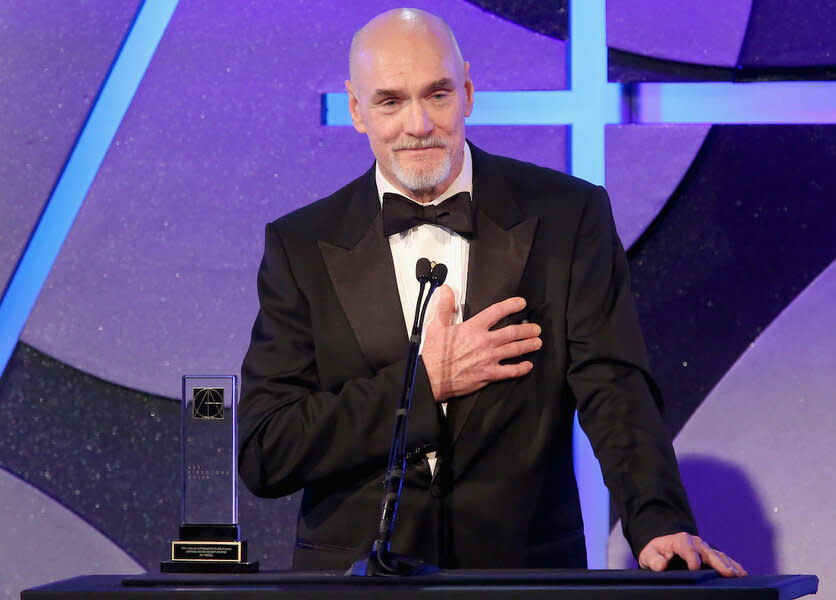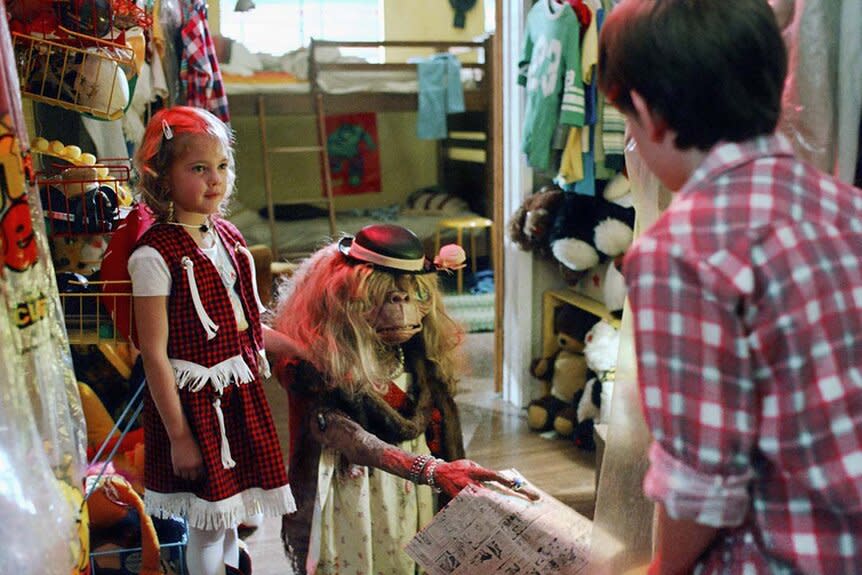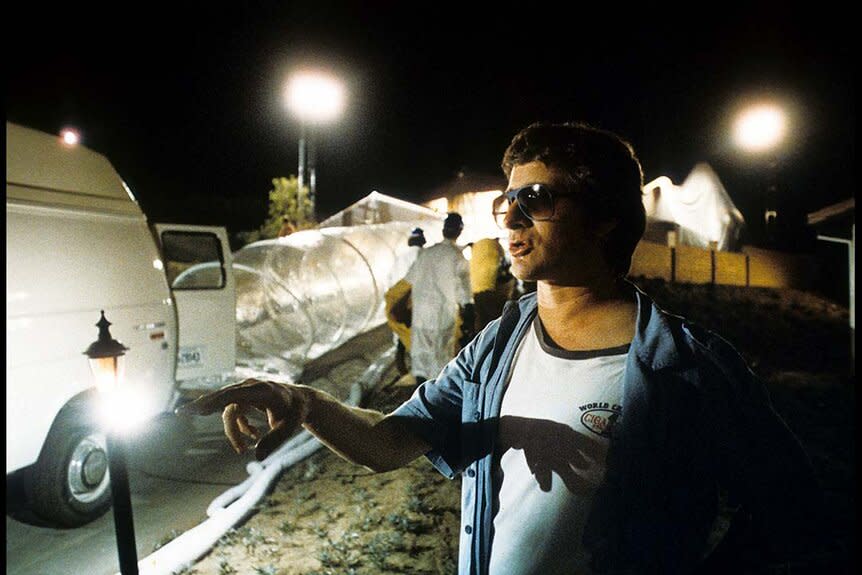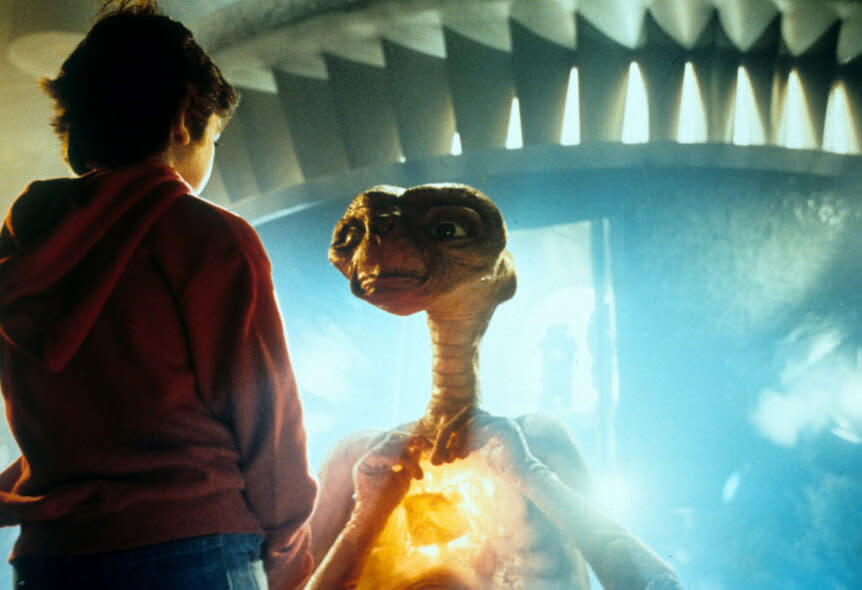E.T. Production Designer Talks Finding "The Ordinary on the Edge of the Extraordinary"
- Oops!Something went wrong.Please try again later.
- Oops!Something went wrong.Please try again later.
- Oops!Something went wrong.Please try again later.
- Oops!Something went wrong.Please try again later.
- Oops!Something went wrong.Please try again later.
What makes E.T. the Extra-Terrestrial (now available to stream on Peacock) such an enduring classic? Is it Steven Spielberg's youthful sensibilities? Melissa Mathison's heartwarming screenplay? John Williams' soaring soundtrack? The way cinematographer Allen Daviau deftly plays with light and shadow? Carlo Rambaldi's lifelike animatronic? A cast of wonderful young actors?
The answer is all of the above and a little something extra, something you can't quite put your finger on; a small touch of magic that endows the film with rightfully-deserved cinematic reverence and immortality.
RELATED: Steven Spielberg Reveals How a Memorable Father-Son Moment in Jaws Helped Inspire E.T.
After 41 years and some change, E.T. production designer, Jim Bissell (credited in the opening titles as James D. Bissell) is able to properly articulate the indescribable. Recently chatting with SYFY WIRE over Zoom, the entertainment veteran throws out a phrase he coined during the production — a phrase that brings the beloved coming-of-age parable into even greater focus: "The ordinary on the edge of the extraordinary."
"I realized that's the essence of dramatic imagery," he continues. "You're always contrasting things to tease out the significant details of whatever it is you're examining. Whatever the environment is that gives context to the action, is something that comes through contrast. That contrast often comes through finding out what's important and what's not. It’s how you explore thematic material."
How E.T. production designer Jim Bissell discovered Elliott's house

Lifetime Achievement Award Recipient Jim Bissell speaks onstage during the 19th Annual Art Directors Guild Excellence In Production Design Awards at The Beverly Hilton Hotel on January 31, 2015 in Beverly Hills, California. (Photo by Photo: Mathew Imaging/WireImage
This driving philosophy, which Bissell has since applied to numerous other projects throughout his career, came about during the search for Elliott's family home. Spielberg had a location picked out "near Simi Valley," but the production designer (then a 29-year-old neophyte with barely any experience in film or television) felt the initial choice was a little too similar to the Freeling house in Poltergeist.
"I looked at it and said, ‘Kathy [producer Kathleen Kennedy], I think we can do better,'" he says. "And she, went, ‘Oh, you can do better than Steven Spielberg?’ I said it honestly, I wasn't trying to be smart or anything like that. She said, ‘Well, let me go talk to Steven.’ She came back and said, ‘Alright, Steven said you can, but you've got a week.’" All these decades later, Bissell realizes just how much was at stake: "If I didn’t find something that just blew them away, I was out of there."
RELATED: The shared story roots of 'E.T the Extra-Terrestrial' and 'Poltergeist'
Over the next few days, Bissell and location services member Dick Vane pored over maps of Los Angeles neighborhoods, feverishly searching for "a typical-looking suburban neighborhood that looked a lot like what Steven really liked in Simi Valley. Only we wanted mountains in the background. We wanted it to look like you could walk out the backyard and go into a magical kingdom."
They ultimately proposed a house in Sunland-Tujunga, correctly divining its potential as an ordinary base from which an extraordinary adventure could emanate. "Elliot can go out the backyard, up a fire road, through a little canyon, and wind up in this magic space," Bissell explains.
But now it was Spielberg's turn to be skeptical, as the production designer showed him around the property a week or so later. "I don’t even know where the footage is, but the owner of the house had a Super 8 mm camera and he took these movies of me, slightly nervous, walking around with a whole bunch of rolled-up drawings tucked under my shoulder, pulling things out, and showing them to Steven ... Anyway, Steven signed off on it and said, ‘Yeah, great.’ I got to keep my job."
All of the house interiors were built on sound stages at Laird International Studios (now known as Culver Studios) with the E.T. puppeteers in mind. In other words, each set was constructed "nine inches off the ground with a series of troughs" housing the cables connected to the sophisticated animatronic. "All the choice of materials, whether it was the carpet in the playroom or the the linoleum patterns in the kitchen, all had this sort of rectilinear quality, so that we could hide the seams of these troughs."
The spaceship landing site was a mixture of soundstage and the iconic Redwood National Park located in Crescent City, California (the latter added to the fairy tale nature of the project). "It’s magical," emphasizes Bissell, "the scale of everything is exaggerated and what better place than to go into a Redwood forest with giant ferns?"
What's the deal with that conjoined closet in E.T. the Extra-Terrestrial?

(L-R) Gertie (Drew Barrymore), E.T., and Elliott (Henry Thomas) appear in E.T. The Extra-Terrestrial (1982). Photo: Sunset Boulevard/Corbis via Getty Images
Forget flying bikes and healing powers! The most unbelievable thing in the film is the closet connecting Elliott's room to Gertie's. "That was the biggest conundrum," Bissell remembers. "Steven wanted it to be a shared closet. How many times have you ever seen that in a house? I’ve never seen it. And yet, most people just accept it."
What's interesting about the closet, however, is that Bissell and the rest of the crew saw it as an opportunity to subtly pay homage to E.T.'s unspoken botanical backstory. "E.T. was there on a plant-gathering expedition. He came from a planet of farmers. And so, we had the stained glass flower in the back [widow], so that was what E.T. looked at that made him feel comfortable when he was there."
E.T. was originally supposed to end in a hospital

Director Steven Spielberg appears between scenes from the film E.T. The Extra-Terrestrial (1982). Photo: Universal/Getty Images
The script originally had the government moving the psychically-linked Elliott and E.T. to "a special isolation ward" at a nearby hospital, though the rest of the third act would have played out in much the same way. About six weeks before principal photography began, though, Spielberg found himself inspired by LAX's then-temporary international terminal — "a big pneumatic structure," Bissell notes — while returning from a trip overseas.
"Steven was coming back through this temporary structure ... and thought, ‘This is cool. What if we don't go to the hospital? What if we cover the house with one of these pneumatic structures?'" Bissell absolutely loved the idea, "because then, the psychological transition completes itself in the house, which is where it should. It's absolutely spot on, this is the way it should happen."
RELATED: How E.T. the Extra-Terrestrial Imagined a Kinder First Contact
It didn't take much to pivot since the production designer was already working with a company that made "mobile sterilized units" for military purposes. The real challenge was figuring out a way to drape the house in plastic, with Bissell honing in on the work of the artist known as Christo "and his work draping cliffs," he says.
"You keep the essence and the form in the shape of the volume of the original material, but it sort of transforms it into something else. I was looking at that going, ‘Wow, what if we take this plastic and just cover the house with it that way? We can drape it and then we just shine the lights from the inside out and turn it into this expressionistic kind of thing.’"
A great idea in theory, but an utter nightmare to pull off in reality. Getting the material over the house required the hiring of two boom arm cranes (the first one was too heavy for the driveway and its driver showed up drunk) and several nerve-wracking attempts. "Eventually, we get it down and it stays in one piece and we do exactly what we planned to do, which was move it back and forth and drape it. As the sun goes down, we turned the beam loose and there it was. Oh, God. It was amazing [but] I thought that was the end of my career."
The importance of color in E.T. the Extra-Terrestrial

Henry Thomas talking with ET in a scene from the film 'E.T. The Extra-Terrestrial', 1982. Photo: Universal/Getty Images
Wanting the sets to reflect Elliott's journey from childhood to maturity, Bissell came up with the idea of juxtaposing color. Where the children's areas were "bright" and full of primary colors, the adult spaces were "drab and gray, a little intimidating." The goal, he clarifies, was not to imply that grown-ups aren't capable of imagination.
"It’s just trying to emphasize the fact that it’s from Elliott's point-of-view. It’s the ordinary on the edge of the extraordinary. It's the world that he's used to, where his imagination flourishes. But he still has the anticipation and a little bit of dread of growing older, especially given the trauma of the divorce of his parents and the uncertainty of adult life."
Fittingly enough, working on the movie had a rejuvenating effect on the crew members, who began to realize that the cynicism of age isn't a permanent affliction. One could even argue that a childlike sense of wonder and discovery is a necessary ingredient for a motion picture capable of withstanding the test of time.
"I brought part of my childhood to it. Steven brought a lot of his childhood to it. We all tapped into our inner child, which is sort of the message of the film," muses Bissell. "When E.T. says, ‘I'll be right here,’ [it means] you’ve got to say goodbye to magical thinking, but you still keep it locked up in your heart and you can go back to it when you need it."
E.T. the Extra-Terrestrial is now streaming on Peacock.

